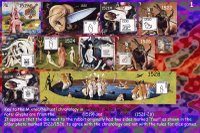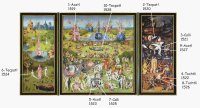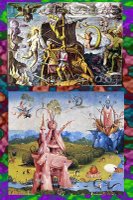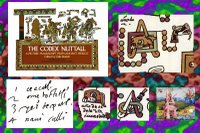

The key to decoding
El Jardín de las Delicias/The Garden of Delights is not identical with its subject. The key is a Nahuatl language chronology that establishes the date of the triptych, and the subject is
vanitas (as in Ecclesiastes 1:2,
vanitas vanitatum dixit Ecclesiastes vanitas vanitatum omnia vanitas), shown here in a seventeenth century painting. The example shown here is from the
Charles Roelofsz collection. The key is more unfamiliar than art historians have expected, and the
vanitas theme seems to have been almost too familiar to see. José de Siguenza hinted at it when he said the subject of the triptych was
madroños.
This is not to say that the triptych was devised as a riddle with its date as the answer. When it was first painted it was probably obvious that it was new, and the people who first saw it may have seen Nahuatl chronologies, the Dresden Codex, and other things from the New World. Other keys to the
vanitas subject include the star maps illustrated below, alchemical images, and the triptych format, which art historians have tended to regard incorrectly as mutually exclusive.
 The main reason El Jardín de las Delicias/The Garden of Delights has remained mostly undeciphered since the late nineteenth century is probably that its iconography is both European and Mexican. Its chronology includes events that are well known on different sides of the Atlantic, and not always remembered as having been simultaneous. But Martin Luther was warned by the Pope to recant or face excommunication on June 15, 1520, and in Mexico the “Noche Triste” took place two weeks later. It is logical to find the glyph for 1520 in a dark hell scene.
The main reason El Jardín de las Delicias/The Garden of Delights has remained mostly undeciphered since the late nineteenth century is probably that its iconography is both European and Mexican. Its chronology includes events that are well known on different sides of the Atlantic, and not always remembered as having been simultaneous. But Martin Luther was warned by the Pope to recant or face excommunication on June 15, 1520, and in Mexico the “Noche Triste” took place two weeks later. It is logical to find the glyph for 1520 in a dark hell scene.













